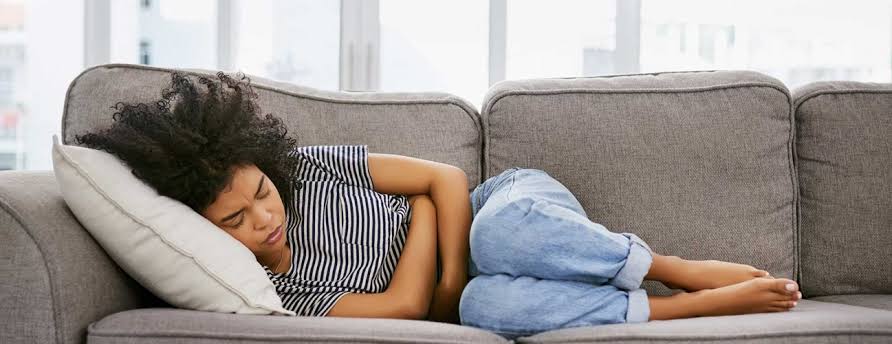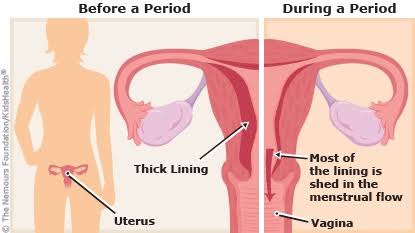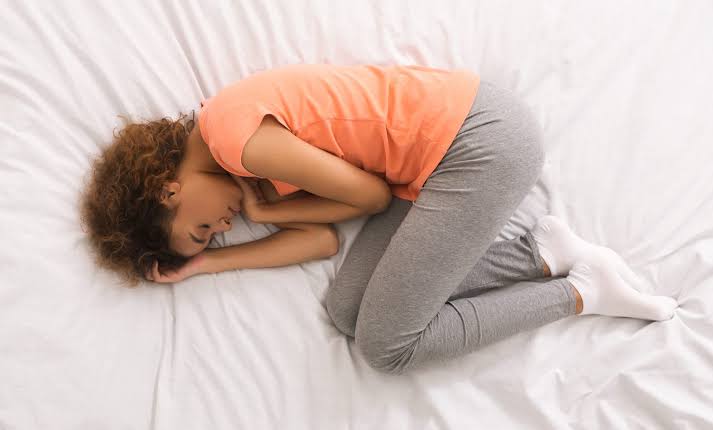Menstrual Cramps: What Should I Do?
Period pains are the absolute worst! (inserts scream). If it had a voice, it would whisper into our ears and say, "I make you uncomfortable, temperamental and teary, and there's absolutely nothing you can do about it".
Well, what if I told you that there was something you could do?
And that you didn’t have to be at the mercy of 'Miss Flow' or her taunts anymore.
I have compiled a few methods of managing menstrual cramps. And I just know that they will be helpful.
What are you waiting for? Sit back, relax and enjoy this read.

What is Menstrual Cramps?
Menstrual cramps, medically known as dysmenorrhea, are pains caused by contractions of the uterus (the uterus is where a baby develops).
The pain ranges from mild, to moderate, and severe, and is usually felt at the lower part of the abdomen and back.
According to a cross-sectional study menstrual pain was reported by 84.1% of women, with 43.1% reporting that pain occurred during every period, and 41% reporting that pain occurred during some periods.
This pain, however, regresses as one gets older. As a woman advances in age, the pains she feels during her mensis reduces.
How Does Menstruation Occur?
This is what happens;
Unless a woman gets pregnant, each month her uterus sheds its lining. This shedding process is propelled by an irregular contraction and relaxation of the uterus.
This helps the tissue lining the uterus detach, and flow, from the uterus through the neck of the uterus (cervix), to the vagina, and out of the body.

Risk factors of menstrual cramps include;
- Ages under 30.
- Early puberty, at or before age 11.
- Heavy bleeding during periods (menorrhagia).
- Irregular menstrual bleeding (metrorrhagia).
- Family history of menstrual cramps.
- Smoking.
- Diet.
- Obesity.
- Depression.
Causes of Menstrual Cramps
Menstrual cramps are majorly divided into two based on its root cause. And they include:
1. Primary dysmenorrhea: Menstrual cramps caused by contractions of the uterus alone is referred to as primary dysmenorrhea. A hormone-like substance called prostaglandin plays an important role here. It stimulates the contraction of the uterus and causes the characteristic pain as well. Similarly, primary dysmenorrhea is more common in women less than 30 and women with heavy bleeding.
2. Secondary dysmenorrhea: These are menstrual cramps caused by conditions secondary to menstruation. These include fibroids, endometriosis, tumors, adenomyosis, pelvic inflammatory disease, ovarian cysts, etopic pregnancy (this is when a fertilized egg implants somewhere else other than the uterus) etc. Secondary dysmenorrhea starts a few days before the period and lasts longer than common menstrual cramps. Unlike primary dysmenorrhea, it isn't accompanied with vomiting, nausea or diarrhea.
Menstrual cramps: What Should I Do?
This is the part you've probably been looking forward to. And we're digging right in.
'What do you do?'
1. Use heat therapy:
Unlike pills or medicine, this leaves no side effects, and has proven to be effective.
What heat therapy does is to relaxe the uterine muscles, and reduce contractions. Ultimately, this relieves pain.
You can use a hot towel, water bottle or a heating pad to apply heat over the lower abdomen for an interval of 10-30 minutes.
Likewise, some people prefer drinking hot water or tea. This works fine as well.
2. Eat right:
Hey sis! Now isn't the time to eat all kinds of junk even though the cravings might be strong.

Those sugar cravings you feel are due to the changes of hormones in your body.
Just before menstruation occurs, there is a drop in the level of progesterone and an increase in oestrogen. This causes the sugar levels to drop, and stimulates cravings.
Nevertheless, your diet can either worsen, or improve your cramps. So, it's important you eat right.
Avoid:
- High-fat containing foods: Foods containing a high amount of fat can trigger inflammation. Inflammation is a protective mechanism of the body and one of the cardinal features is pain. You do NOT want that.
- Sugar: Avoid sugar containing foods and I'm not talking about just candy or potato chips, but foods like bread and pasta. These foods can be broken down into smaller bits (sugar), which is easily absorbed into the blood stream. Sugar induces inflammation, resulting in pain. Incase you've not noticed, sugar isn't your friend during your period.
- Dairy products such as milk, cheese, and cream: They contain a high level of arachidonic acid and can worsen pain.
- Alcohol: Alcohol is bad for you during your menses. It stimulates an inflammatory response and also increases the levels of progesterone and estrogen. Too much of either hormones can worsen menstrual cramps. According to some, alcohol reduces cramps. It should be noted, however, that alcohol is a diuretic. Diuretics increases urination which leads to dehydration. And dehydration in itself worsens cramps.
- Caffeine: Caffeine will exacerbate your symptoms due to it's vasoconstrictive and diuretic effect. In other words, Adios Caffeine! (at least during your menstruation).
Enough of the don'ts, what should you eat or drink?
- Sip chamomile tea: This provides an anti-prostaglandic effect. Prostaglandin, as stated earlier, is a hormone-like substance which is released during menstruation. This substance is responsible for uterine contractions, causing pain. This released prostaglandin in the bloodstream is responsible for the symptoms of menstrual cramps (nausea, vomiting and migraine). Chamomile tea is anti-inflammatory and inhibits the release of prostaglandin. Less prostaglandin released, less pain. Voila!
- Cinnamon and ginger: Studies has shown that cinnamon and ginger cause a significant reduction of menstrual symptoms. You might want to incorporate some cinnamon and ginger into your diet.
- Anti-inflammatory foods like cherries, blueberries, squash, tomatoes, and bell peppers are beneficial. Remember, we don't want to induce inflammation which will result in pain.
- Dietary supplements like magnesium, calcium, vitamins B6, B1, E, and vitamin B12 can be taken as well.
3. Drink more water:
You should drink more water, because you're prone to losing more bodily fluids and becoming dehydrated during your period.
"At the start of your menstrual cycle, your hormone levels progesterone and estrogen are low, and this can cause your body to retain water, which can leave you feeling bloated and sluggish," Kendra Segura, MD, an ob-gyn in southern California, told Popsugar.
"Drinking at least eight glasses of water per day can help to relieve bloating, muscle cramps, and fatigue," Dr. Segura said.
Water is highly beneficial, and should be taken frequently during menstruation.
4. Also try these techniques:
- Sleep in a fetal position: Sleeping in a fetal position helps in easing pressure from the muscles in the abdomen, and less pressure equals less pain. In the fetal position, the body lies curled up on one side with the arms and legs pulled in close. It is called fetal position because it resembles the position of the fetus in the womb.

- Soak in a tub: The water should be preferably warm. A nice, warm soak in the tub might be just what you need. This should be done for at least 15 minutes. It can be more, however, depending on how uneasy feel.
- An abdominal massage is also recommended.
- Exercise: The Cochrane Review Exercise for dysmenorrhoea (September 2019) looked at all of the relevant evidence for exercise for period pain. The review was conducted on 700 young women (under 25) with moderate to severe period pain. The results showed that those who exercised experienced a reduction in pain, compared to those who didn't exercise at all. Evidence suggests that exercise may be effective in reducing period pain levels by 25mm on a 100mm scale.
Puteri Zainuddin (ST1 Obstetrician and Gynaecology doctor) and Emily Carter (ST5 Registrar in Obstetrics and Gynaecology) reviewed the results and had this to say; "As the reduction of pain described was so large, this gives women who suffer from period pain hope that their symptoms could be managed by exercise, which could be a simple lifestyle modification. However, as the certainty of the evidence is low, more trials are needed to confirm these findings both in women under 25, and older women".
It should also be noted, however, that exercise can worsen symptoms. Some research shows that exercise might not be the best option for period pains.
5. Take pain relievers:
This is one of the most common ways of handling menstrual cramps. It is effective too, although it might cause side effects. NSAIDS (Non-Steroidal Anti-Inflammatory Drugs) are the most effective. They work by inhibiting inflammatory features which include pain, warmth, redness and swelling. Examples of over-the-counter NSAIDS are; Ibuprofen, Diclofenac, Ketoprofen and Naproxen.
Period cramps are normal. However, if the pain is overbearing and is consistently messing up with your activities, it might be time to see your doctor.
I'm rooting for you! And I hope these tips help you.
0 Comments Add a Comment?